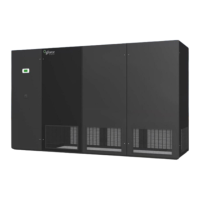Table 7 Packaged Units with Receivers
Acceptable parameters range for water/glycol packaged units with receivers, with return air temperature
of 65°F to 85°F and entering water/glycol temp of 65 - 85°F
Liquid Line
Pressure PSIG (kPa)
Suction
Pressure PSIG
(kPa)
Suction Sat.
Temp °F (°C)
290 to 390
(1999 to 2689)
85 to 100
(29.4 to 37.8)
103 to 130
(710 to 896)
or greater
0 to 3°
(-17.8 to -16.1)
12 to 18
(-11.1 to -7.8)
245 to 285
(1689 to 1965)
106 to 115
(41.1 to 46.1°)
53 to 70
(365 - 483)
or greater
0 to 3°
(-17.8 to -16.1)
8 to 15°
(-13.3 to -9.4°)
Measure the superheat at the compressor suction line at least 6 inches (152 mm) away from
the compressor.
All water/glycol cooled units have a water regulating valve. A head pressure transducer is
connected to a Schrader fitting on the discharge line and water is regulated into the condenser
coil (plate fin condensers are standard).
WARNING: If the system is charged from a vacuum, the preheating of
the compressor is not necessary. But if starting a compressor that has not
been charged from a vacuum, the crankcase heater must be energized
for a minimum of 12 hours to reduce the possibility of liquid slugging on
start-up. Failure to energize the crankcase heater could result in
compressor damage.
Refrigerant Handling
The use of recovery/recycling units is required by U.S. Environmental Protection Agency
(EPA) regulations. Technicians who service and dispose of air conditioning and refrigeration
equipment must recover the refrigerant instead of venting it to the atmosphere.
Except for extremely small releases of refrigerant such as what occurs when disconnecting
service hoses, a technician who knowingly releases or vents refrigerant to the atmosphere is in
violation of this regulation. Refrigerant purchasers must be certified technicians and have a
valid EPA certification card.
WARNING: Pressure relief lines(s) must be vented to the atmosphere per
the latest edition of ASHRAE Standard 15 and/or any local building, fire or
mechanical codes.
This applies to all units with either shell and tube condensers or high-pressure relief valve
options.

